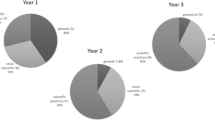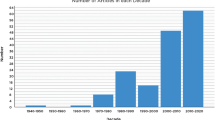Abstract
This paper explores final-year physical sciences preservice teachers’ religious and scientific views regarding the origin of the universe and life. Data was obtained from 10 preservice teachers from individual in-depth interviews conducted at the end of the Science Method module. Their viewpoints were analyzed using coding, sorting, and categorizing. They attributed the origin of the universe and life to a blend of theistic, intelligent design or scientific beliefs. Moreover, their academic backgrounds, exposure to topics in Cosmology in the Science Method module, and classroom dialogues did not significantly influence or change their original religious beliefs. However, the dialogues did create an awareness of their own reflected positions regarding the tenacity of beliefs in religion and their inadequate cosmological understandings. The paper has implications for Science Education in addressing preservice teachers’ religious beliefs in contrast to scientific evidence.
Similar content being viewed by others
References
American Association of Physics Teachers (2000). American Association of Physics Teachers statement on the teaching of evolution and cosmology. American Journal of Physics, 68(1), 11.
Aikenhead, G. S. (2001). Integrating western and aboriginal sciences: Cross-cultural science teaching. Research in Science Education, 31, 337–355.
Aikenhead, G. S. (2006). Science education for everyday life: Evidence-based practice. New York, NY: Teachers College Press.
Alexakos, K. (2009). Science and creationism: A response to Kenneth Tobin. Cultural Studies of Science Education, 4, 495–504.
Arriassecq, I. & Rivarosa, A. (2014). Science teaching and research in Argentina: The contribution of history and philosophy of science. In M. R. Matthews (Ed.), International Handbook of Research in History, Philosophy and Science Teaching (pp. 2301–2326). London, England: Springer.
Brandt, C. B. (2007). Epistemology and temporal/spatial orders in science education: A response to Aikenhead & Ogawa’s: Indigenous knowledge an science revisited. Cultural Studies of Science Education, 2(3), 599–605.
Brickhouse, N. W., Dagher, Z., Letts, W. J., & Shipman, H. L. (2000). Diversity of students’ views about evidence, theory, and the interface between science and religion in an astronomy course. Journal of Research in Science Teaching, 37(4), 340–362.
Brooke, J. & Cantor, G. (2000). Reconstructing nature: The emergence of science and religion. Edinburgh, Scotland: T&T Clark.
Caleon, I., Wui, L. M. G., & Regaya, M. H. P. (2015). Personal beliefs as key drivers in identifying and solving seminal problems: Lessons from Faraday, Maxwell, Kepler and Newton. Science Education International, 26(1), 3–23.
Clément, P. (2015). Creationism, science and religion: A survey of teachers’ conceptions in 30 countries. Procedia-Social and Behavioral Sciences, 167, 279–287.
Colburn, A. & Henriques, L. (2006). Clergy views on evolution, creationism, science, and religion. Journal of Research in Science Teaching, 43(4), 419–442.
Comins, N. E. (2000). Heavenly errors: Misconceptions about the real nature of the universe. New York, NY: Columbia University Press.
Coveleski, J. F. (2008). Three why’s: Religion and science in school. Educational Studies, 43, 7–16.
Darwin, C. (2009). The origin of species and the voyage of the beagle. London, England: Vintage.
Dawkins, R. (2007). The God delusion. Berkshire, England: Transworld.
Dickerson, D. L., Dawkins, K. R., & Penick, J. E. (2008). Clergy’s views of the relationship between science and religious faith and the implications for science education. Science & Education, 17, 359–386.
El-Hani, C. N. & Sepulveda, C. (2010). The relationship between science and religion in the education of protestant biology preservice teachers in a Brazilian university. Cultural Studies of Science Education, 5(1), 103–125.
Fraknoi, A. (2005). The challenge of creationism and intelligent design: an introduction. Astronomy Education Review, 4(1), 1–5.
Glennan, S. (2009). Whose science and whose religion? Reflections on the relations between scientific and religious worldviews. Science & Education, 18, 797–812.
Gould, S. J. (1997). Nonoverlapping magisteria. Natural History, 106(2), 16–25.
Grünbaum, A. (1996). Theological misinterpretations of current physical cosmology. Foundations of Physics, 26(4), 523–543.
Hewson, M. G. & Ogunniyi, M. B. (2011). Argumentation-teaching as a method to introduce indigenous knowledge into science classrooms: Opportunities and challenges. Cultural Studies of Science Education, 6(3), 679–692.
Horsthemke, K. & Yore, L. D. (2014). Challenges of multiculturalism in science education: indigenisation, internationalisation, and transkulturalität. In M. R. Matthews (Ed.), International handbook of research in history, philosophy and science teaching (pp. 1759–1792). London, England: Springer.
Hsieh, H.-F. & Shannon, S. E. (2005). Three approaches to qualitative content analysis. Qualitative Health Research, 15(9), 1277–1288.
Kragh, H. (2011). On modern cosmology and its place in science education. Science & Education, 20(3-4), 343–357.
Kragh, H. (2014). The science of the universe: Cosmology and science education. In M. R. Matthews (Ed.), International handbook of research in history, philosophy and science teaching (pp. 643–665). London, England: Springer.
Kuhn, T. (1970). The structure of scientific revolutions (2nd ed.). Chicago, IL: University of Chicago Press.
Levinson, M. H. (2006). Science versus religion: a false dichotomy? ETC: A Review of General Semantics, 63, 422–429.
Loving, C. & Foster, A. (2000). the religion-in-the-science-classroom issue: seeking graduate student conceptual change. Science Education, 84, 445–468.
Mahner, M. (2014). Science, religion, and naturalism: metaphysical and methodological incompatibilities. In M. R. Matthews (Ed.), International Handbook of Research in History, Philosophy and Science Teaching (pp. 1793–1835). London, England: Springer.
Mahner, M. & Bunge, M. (1996). Is religious education compatible with science education? Science & Education, 5, 101–123.
Matthews, M. R. (2009). Science, worldviews and education: An introduction. Science & Education, 18, 641–666.
Matthews, M. R. (2014). Science, worldviews and education. In M. R. Matthews (Ed.), International handbook of research in history, philosophy and science teaching (pp. 1585–1635). London, England: Springer.
McCarthy, C. L. (2014). Cultural studies in science education: Philosophical considerations. In M. R. Matthews (Ed.), International handbook of research in history, philosophy and science teaching (pp. 1927–1964). London, England: Springer.
Meadows, L., Doster, E., & Jackson, D. F. (2000). Managing the conflict between evolution & religion. The American Biology Teacher, 62(2), 102–107.
Pal, H. S. (2011). God of the gaps. Scientific GOD Journal, 2(6), 635–637.
Pennock, R. T. (2002). Should creationism be taught in the public schools? Science & Education, 11(2), 111–133.
Plantinga, A. (1990). God and other minds: A study of the rational justification of belief in God. Ithaca, NY: Cornell University.
Polkinghorne, J. (2005). Exploring reality: The intertwining of science and religion. New Haven, CT: Yale University Press.
Prather, E. E., Slater, T. F., & Offerdahl, E. G. (2002). Hints of a fundamental misconception in cosmology. Astronomy Education Review, 1(2), 1–7.
Reiss, M. (2010). Science and religion: implications for science educators. Cultural Studies of Science Education, 5, 91–101.
Reiss, M. (2014). What significance does Christianity have for science education? In M. R. Matthews (Ed.), International handbook of research in history, philosophy and science teaching (pp. 1637–1662). London, England: Springer.
Roth, W. M. (2007). The interaction of students’ scientific and religious discourses: Two case studies. International Journal of Science Education, 19(2), 125–146.
Roth, W. M., Lee, Y. J., & Hwang, S. W. (2008). Culturing conceptions: From first principles. Cultural Studies of Science Education, 3, 231–261.
Sherkat, D. E. (2007). Religion and higher education: The good, the bad, and the ugly. Retrieved from http://religion.ssrc.org/reforum/Sherkat.pdf.
Shipman, H. L., Brickhouse, N. W., Dagher, Z., & Letts, W. J. (2002). Changes in student views of religion and science in a college astronomy course. Culture and Comparative Studies, 86, 526–547.
Simonton, D. K. (2004). Creativity in science: Chance, logic, genius, and zeitgeist. Cambridge, England: Cambridge University Press.
Stake, R. E. (2005). Qualitative case studies. In N. K. Denzin & Y. S. Lincoln (Eds.), The sage handbook of qualitative research (pp. 443–466). Thousand Oaks, CA: Sage.
Tignanelli, H. & Benétreau-Dupin, Y. (2014). Perspectives of history and philosophy on teaching astronomy. In M. R. Matthews (Ed.), International handbook of research in history, philosophy and science teaching (pp. 603–640). London, England: Springer.
Acknowledgments
The author acknowledges the early discussions and contributions by the late Professor Herby Govinden towards Cosmology education research.
Author information
Authors and Affiliations
Corresponding author
Rights and permissions
About this article
Cite this article
Govender, N. Physical Sciences Preservice Teachers’ Religious and Scientific Views Regarding the Origin of the Universe and Life. Int J of Sci and Math Educ 15, 273–292 (2017). https://doi.org/10.1007/s10763-015-9695-5
Received:
Accepted:
Published:
Issue Date:
DOI: https://doi.org/10.1007/s10763-015-9695-5




